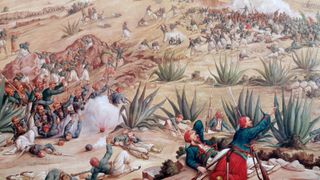Cinco de Mayo: History and facts about the celebration of Latin culture
Cinco de Mayo is an annual celebration of Latin culture, with origins in a 19th-century battle.

Observed every year on May 5, the holiday Cinco de Mayo has its origins in a famous Mexican military victory. However, over the years the event has grown into a celebration of Latino heritage and culture, and is now celebrated across much of North America.
Although the pandemic did put a hold on many of the festivals and parades, which had become popular especially in the U.S., celebrations are now returning to normal — eating, drinking, dancing and… racing Chihuahuas.
Here are five facts about this holiday and how it is celebrated.
It began because of a famous battle

Cinco de Mayo, which means the 5th of May in Spanish, is often wrongly thought to be the date of Mexico's independence from Spain. That date, also a holiday is called Grito de Dolores (or El Grito de la Independencia) and is observed every Sept. 16.
Cinco de Mayo actually marks the anniversary of the Battle of Puebla (May 5, 1862) which took place between the Mexican and the French armies. In 1861 the Mexican government stopped making repayments on a large debt it owed to the French emperor, Louis-Napoléon Bonaparte. To collect the debt, the emperor dispatched French soldiers to occupy portions of Mexico — seizing the money through a land-grab.
At Puebla — which is approximately 80 miles (129 kilometers) east of Mexico City — approximately 4,000 Mexican stood firm against around 6,000 French soldiers. The French, who were much better equipped than their enemy, were were led by Commander Charles Ferdinand Latrille. On the day, the Mexican army, led by General Ignacio Zaragoza, inflicted about 1,000 killed, more wounded, and forced the survivors to retreat to Mexico's Gulf coast.
Though the French returned the following year and successfully captured both Puebla and Mexico City, the Mexicans eventually won the war in 1867. The battle against the odds at Puebla on May 5 remains among the most famous Mexican victories.
It's a bigger party in the U.S. than in Mexico
In Mexico, Cinco de Mayo is a regional holiday in the state and city of Puebla, and is mainly celebrated with large parades. Neighboring areas, including Veracruz and Mexico City, also observe the holiday with festivities, however unlike Grito de Dolores the holiday is not commemorated throughout all of Mexico.
In the U.S., Cinco de Mayo began to become more popular in the 1940s, during the rise of the Chicano (or Mexican American) movement, according to TIME magazine. Today, Cinco de Mayo is actually more widely celebrated north of the border than it is in the south, with parades, festivals and Cinco de Mayo-themed parties held throughout the U.S.
The world's largest events were in California
Prior to the COVID-19 Pandemic, the Festival de Fiesta Broadway was one of the largest Cinco de Mayo events in the world, attracting as many as 600,000 people with its colorful array of Mexican food, music and dancing.
The festival is named after the street it is held on in Los Angeles, Calif., where every year up to 24 square blocks were barricaded off to make room for the event.
In 2022, festivities are back on the schedule, with events across the country.
It's honored with Chihuahua races and beauty pageants

Prior to the pandemic, an average of 7,000 people attended the Cinco de Mayo festival in Chandler, Ariz., and although it's not as big as the Festival de Fiesta Broadway, this fiesta has its own unique flair: what it lacks in size, it makes up for in Chihuahuas. Lots and lots of Chihuahuas.
"This festival is known for its Chihuahuas," Alberto Esparza, an official representative for the city government-sponsored event, told Life's Little Mysteries. "We have a Chihuahua parade, as well as Chihuahua races and pageants."
The race has consisted of 150 purebred Chihuahuas and takes place on a tiny track set up especially to accommodate the small breed. After the race winners are announced, the "king and queen coronation" takes center stage. The king and queen Chihuahuas are judged based on who is the best dressed, has the best temperament and is the most fashionable. The winners receive a medal and royal cape.
Since the popularity of the Chihuahua-themed Cinco de Mayo celebrations, other similar events have popped up in different states, including Washington D.C., where the "Running of the Chihuahuas" is set for May 7, 2022.
The Battle of Puebla is re-enacted annually

Traditionally, the Battle of Puebla is re-enacted by the citizens of Puebla, Mexico, during their Cinco de Mayo festival. Participants dress up in 19th-century uniform, carrying machetes and old-fashioned rifles.
Those representing the French soldiers wear knapsacks with wine bottles sticking out of them, and some dress in the elaborate blue-and-red zouave uniform associated French infantry in this period. In addition, women dress in long skirts and flowery hats represent the soldaderas, or "female fighters" that cooked and cared for the Mexican army.
Rifle shots ring out and cannon blasts roar during the mock battle, until the Mexican and French generals meet face-to-face for a dramatic sword fight finale — the Mexican general of course emerges victorious. Ordinarily the Battle of Puebla is also re-enacted in several parts of the U.S., including San Diego's Old Town and Heritage Park in San Diego, Calif.
Sign up for the Live Science daily newsletter now
Get the world’s most fascinating discoveries delivered straight to your inbox.
